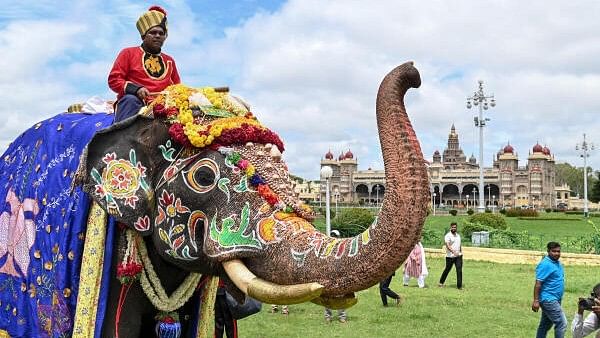
Mysuru Dasara elephant.
Credit: DH Photo
Mysuru: Incidents of Mysuru Dasara elephants running amok, in Srirangapatna on Friday, and on Mysuru Palace premises on September 20, have once again brought to the fore, the question of using wild animals, although tamed and trained, for religious and cultural events.
The issue is debated whenever there is either a disturbance or a tragedy caused by these animals. However, no one shows the will, to pursue the issue to a logical end. Most of them cite culture and tradition for continuation of the use of tamed elephants in events like Mysuru Dasara. Over the past one decade, elephants are being used in Srirangapatna Dasara too.
Following the September night incident, Environment Minister Eshwar Khandre had warned the Forest officials, not to allow photo shoots or making of reels (social media videos), featuring Dasara elephants.
Dr D N Nagaraju, who was veterinarian for Dasara elephants for 21 years, up to December 2020, said, choosing the right kind of elephants and training them to gain experience is vital as they have to march in cities, that too amid crowd.
“Each elephant has a different character, like human beings. Some elephants get either disturbed or afraid easily, while some stay cool under adverse circumstance. Besides, the elephants need experience, to deal with people, urban animals like dogs and cattle, and also noise in an urban setup. The primary training should be at least five years in forest camps. Then, for another five years on Mysuru Palace premises, and finally on Raja Marga or Jamboo Savari procession route,” Dr Nagaraju said.
It can be noted that the Forest department had released a list of do’s and dont’s on September 13, to be followed around Dasara elephants.
Forest officials gave a list of etiquette reminders or rules, to be followed by the people or tourists, when the elephants are taken out for a training for Dasara Jamboo Savari procession, in the morning or evening.
DCF (wildlife) I B Prabhu Gowda had urged the people, to follow the instructions of the mahouts of the elephants.
"They should maintain a safe distance from the elephants and keep children away from them. They should neither throw flowers at them nor feed them. They should not follow them. They should avoid flash photography. They should not click photos or videos standing next to the elephants. They should avoid crossing the road in front of the elephants. They should not approach the elephants with vehicles and should not honk, when they are around," he had urged.
According to Arun Prasanna of People for the Ethical Treatment of Animals (PETA) India, “The September 20 fight between two Dasara elephants in Mysuru could have put the lives of the elephants themselves, and humans, at risk”.
“Use of mechanical elephants might change that, allowing devotees to maintain their tradition and the elephants to remain in their jungle homes. Earlier, PETA India had protested against the use of live elephants in Mysuru’s Dasara procession. It had pointed out that the elephants are used in performances, without permission from the Animal Welfare Board of India,” Prasanna said.
“During Dasara, elephants are forced to walk over five km, with heavy weight on their backs — howdah elephant is forced to carry the 750 kg golden howdah. This, plus loud chaos of the crowd, fireworks and music upsets the elephants,” he said.
Prasanna said, the Dasara procession violate sub-sections (a), (b), (h), (k), and (x) under the caption ‘Acts which are tantamount to cruelty to elephants’ of the Captive Elephant Guidelines, which prohibit specific acts of extreme cruelty, and also sub-sections (a), (b), (c), (f) and (g) of Condition F, titled ‘Procession and Display’ of the Guidelines for the Management and Maintenance of Privately Owned Elephants in Karnataka State, dated September 11, 2017, which lay down specific requirements, for elephant processions, as well as the ‘Guidelines for Care and Management of Captive Elephants Management’, issued by the Union government, under Project Elephant vide their letter No.9-5/2003, dated January 8, 2008,” he said.
Furthermore, using elephants for processions such as Dasara festivals often results in violations of The Prevention of Cruelty to Animals Act, 1960, Performing Animals Registration Rules, 2001, and Wildlife (Protection) Act (WPA), 1972, Prasanna said.